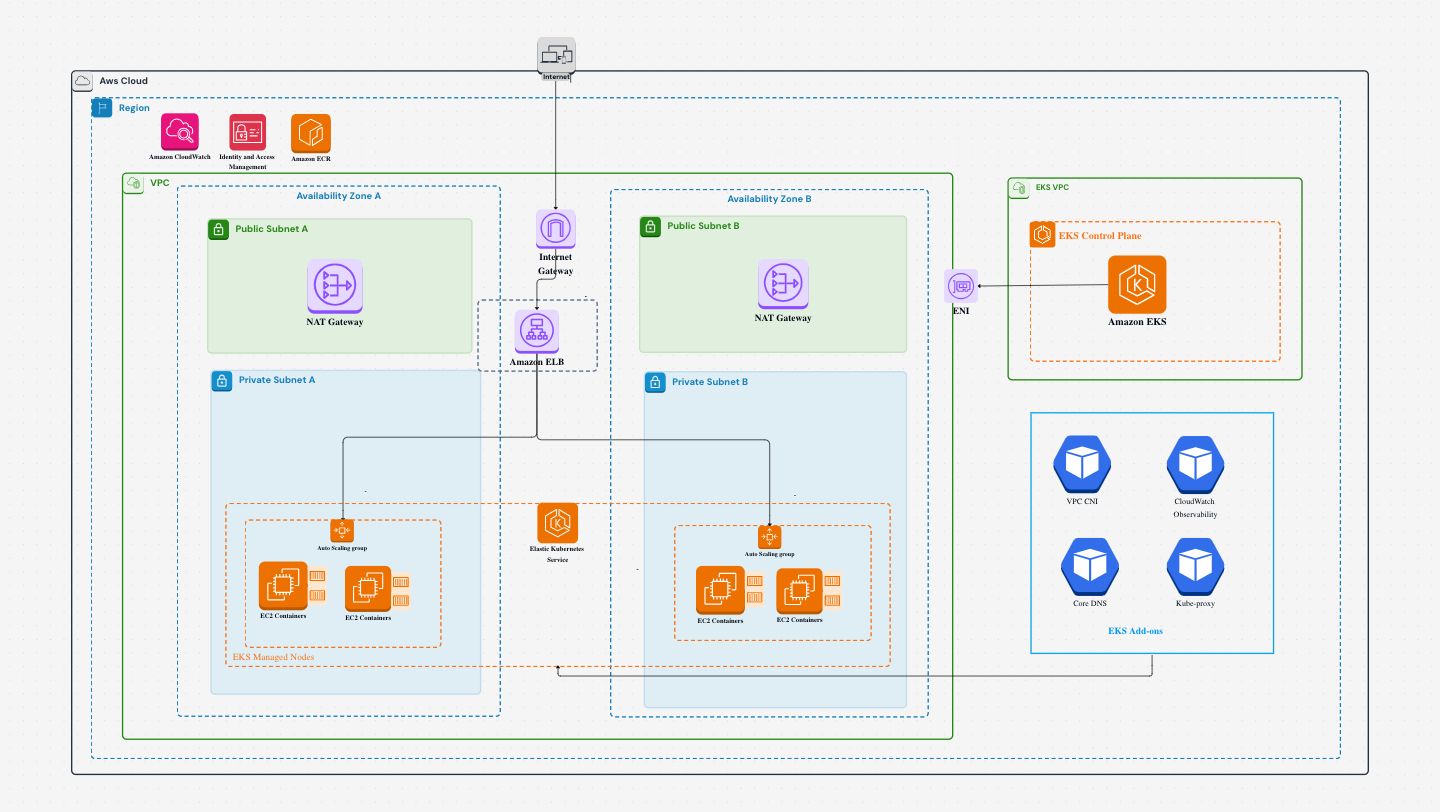Works
Portfolio EKS
Portfolio
Building Efficient Kubernetes Infrastructure with Terraform and Blueprints Addons

A comprehensive project deploying a sample web application using Terraform EKS modules and add-ons. My focus was on establishing robust networking, efficient cluster provisioning, essential add-ons, and comprehensive monitoring to ensure a seamless deployment experience. The solution includes a multi-AZ VPC with private and public subnets, Amazon EKS running across private subnets, ELB for traffic routing, auto-scaling for dynamic capacity management, and CloudWatch Observability for real-time monitoring.
• A multi-AZ VPC with private and public subnets for secure and scalable networking.
Provision Amazon EKS clusters with Terraform Blueprints, abstracting infrastructure complexity and promoting reuse across environments.
• Amazon EKS control plane and worker nodes running across private subnets.
• EKS Managed Node Groups with auto-scalingfor dynamic workload management.
• Elastic Load Balancer (ELB) for routing external traffic.
• CloudWatch Observability for real-time monitoring.
The architecture is designed for high availability, security, and operational excellence, consisting of:
𝐁𝐮𝐢𝐥𝐝𝐢𝐧𝐠 𝐚 𝐍𝐞𝐭𝐰𝐨𝐫𝐤𝐢𝐧𝐠 𝐅𝐨𝐮𝐧𝐝𝐚𝐭𝐢𝐨𝐧 𝐰𝐢𝐭𝐡 𝐓𝐞𝐫𝐫𝐚𝐟𝐨𝐫𝐦
Using Terraform VPC modules allows for consistent and repeatable infrastructure deployment with these key components:
• A multi-AZ network with private subnets for worker nodes.• NAT Gateways to allow outbound internet access from private subnets.
• Security Groups and Network ACLs to control traffic between subnets, ensuring fine-grained access control and a secure environment.
𝐃𝐞𝐩𝐥𝐨𝐲𝐢𝐧𝐠 𝐚𝐧 𝐄𝐊𝐒 𝐂𝐥𝐮𝐬𝐭𝐞𝐫 𝐰𝐢𝐭𝐡 𝐓𝐞𝐫𝐫𝐚𝐟𝐨𝐫𝐦
With Terraform EKS modules, we can automate the entire cluster provisioning process, dramatically reducing the complexity while ensuring consistent deployments:
• Provisioning the EKS control plane in a dedicated VPC.• Deploying worker nodes in auto-scaling groups across private subnets.
• IAM role assignments to securely manage cluster access.
𝐄𝐧𝐡𝐚𝐧𝐜𝐢𝐧𝐠 𝐄𝐊𝐒 𝐰𝐢𝐭𝐡 𝐓𝐞𝐫𝐫𝐚𝐟𝐨𝐫𝐦 𝐀𝐝𝐝-𝐨𝐧𝐬 𝐚𝐧𝐝 𝐍𝐚𝐭𝐢𝐯𝐞 𝐂𝐚𝐩𝐚𝐛𝐢𝐥𝐢𝐭𝐢𝐞𝐬
To optimize networking and observability, we leverage both the Terraform-managed resources and native EKS features:
• VPC-CNI for efficient pod networking within the VPC.• CloudWatch Observability for real-time logs, metrics, and performance monitoring.
• AWS Load Balancer Controller for automated ALB/NLB provisioning and traffic management.
𝐈𝐧𝐭𝐞𝐠𝐫𝐚𝐭𝐢𝐧𝐠 𝐀𝐦𝐚𝐳𝐨𝐧 𝐄𝐊𝐒 𝐂𝐥𝐨𝐮𝐝𝐖𝐚𝐭𝐜𝐡 𝐂𝐨𝐧𝐭𝐚𝐢𝐧𝐞𝐫 𝐈𝐧𝐬𝐢𝐠𝐡𝐭𝐬
Amazon CloudWatch Container Insights provides deep visibility into cluster operations by:
• Tracking CPU and memory utilization per pod.• Integrating logs and metrics for proactive monitoring and troubleshooting.
• Enhancing operational efficiency with real-time alerts and dashboards.
AWS Services and Tools Used
• Amazon EKS: EKS clusters are provisioned and auto-scaling node groups are used to efficiently handle workloads.
• Amazon VPC: A multi-AZ VPC with private and public subnets ensures secure, scalable networking for the EKS deployment.
• Amazon ELB: Routes external traffic to the application in the EKS cluster.
• NAT Gateways: Used to allow outbound internet access for worker nodes in private subnets.
• CLoudWatch Container Insights: Collects metrics and logs from the EKS pods, enabling proactive monitoring of CPU, memory, and performance metrics.
• VPC-CNI (Amazon VPC CNI Plugin for Kubernetes): Ensures seamless pod-to-pod networking in the VPC and enables efficient networking across your EKS cluster.
• AWS IAM: IAM roles are assigned to nodes in the EKS cluster to ensure secure access control.
Best Practices for building Efficient Kubernetes Infrastructure with EKS and Terraform
• Terraform simplifies infrastructure as code (IaC), making EKS and VPC deployments scalable and repeatable.
• A well-architected VPC with private subnets improves security and isolation.
• EKS Blueprints Add-ons optimize networking (VPC-CNI), observability (CloudWatch), AWS Load Balancer controller.
• CloudWatch Container Insights offers real-time monitoring for proactive issue resolution.